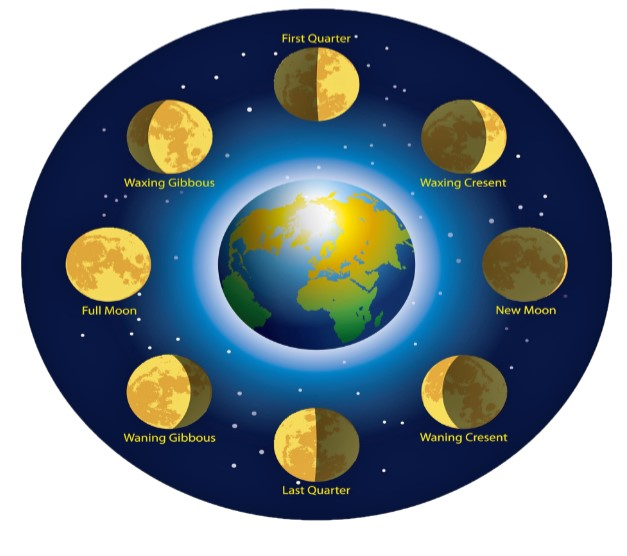
Why can we not see the moon on the new moon day?
A. Earth faces the non-illuminated part of the moon.
B. There is no moon in the sky.
C. The moon is on the other side of the Earth.
D. The moon’s size diminishes and it disappears.
Answer
566.7k+ views
Hint: The first primary phase of the moon is the new moon. It occurs when the Moon and the Sun are lined up with the Earth and the Sun on the opposite side of the Moon.
Complete step-by-step solution:
To solve this question, first, we have to know about the phases of the moon. Viewed from the planet, the moon appears to change its form nearly every day. But this is nothing more than an illusion created by the position of the sun and the earth in relation to the moon. Such illusionary aspects of the moon are called the phases of the moon. The moon is going to make a full revolution around the earth in about 28 days. It takes the same time to complete a rotation around its axis.
So, we always stare at the same side of the moon. The moon moves around the earth, and the earth moves around the sun. Because of these motions, various portions of the moon’s face towards the earth are illuminated at different times.

Fig: Various phases of moon.
Now, let us find the solution from the given options -
When the side of the moon facing the earth reflects no sunlight, we cannot see the moon. This is called the new moon.
When a small portion of the moon is visible in the light, it is called a crescent moon. When half the moon can be seen in the sunlight, it is called the half moon. When three-quarters of the moon is visible, it is called gibbous moon. When the entire side of the moon facing the earth gets sunlight, we see the full moon.
Thus, the right answer is option A. i.e., Earth faces the non-illuminated part of the moon.
Note: The phases of the Moon are caused by the shadow of the Sun or by the rotation of the Moon or the Earth. Half of the surface of the Moon is always illuminated by sunlight. So how much of the light we could see from our viewpoint on Earth differs every day, and because of this we call the phases of the Moon.
Complete step-by-step solution:
To solve this question, first, we have to know about the phases of the moon. Viewed from the planet, the moon appears to change its form nearly every day. But this is nothing more than an illusion created by the position of the sun and the earth in relation to the moon. Such illusionary aspects of the moon are called the phases of the moon. The moon is going to make a full revolution around the earth in about 28 days. It takes the same time to complete a rotation around its axis.
So, we always stare at the same side of the moon. The moon moves around the earth, and the earth moves around the sun. Because of these motions, various portions of the moon’s face towards the earth are illuminated at different times.

Fig: Various phases of moon.
Now, let us find the solution from the given options -
When the side of the moon facing the earth reflects no sunlight, we cannot see the moon. This is called the new moon.
When a small portion of the moon is visible in the light, it is called a crescent moon. When half the moon can be seen in the sunlight, it is called the half moon. When three-quarters of the moon is visible, it is called gibbous moon. When the entire side of the moon facing the earth gets sunlight, we see the full moon.
Thus, the right answer is option A. i.e., Earth faces the non-illuminated part of the moon.
Note: The phases of the Moon are caused by the shadow of the Sun or by the rotation of the Moon or the Earth. Half of the surface of the Moon is always illuminated by sunlight. So how much of the light we could see from our viewpoint on Earth differs every day, and because of this we call the phases of the Moon.
Recently Updated Pages
Class 12 Question and Answer - Your Ultimate Solutions Guide

Master Class 12 Chemistry: Engaging Questions & Answers for Success

Master Class 12 Physics: Engaging Questions & Answers for Success

Master Class 12 Business Studies: Engaging Questions & Answers for Success

Master Class 12 Maths: Engaging Questions & Answers for Success

Master Class 10 Computer Science: Engaging Questions & Answers for Success

Trending doubts
What is BLO What is the full form of BLO class 8 social science CBSE

What is 1 divided by 0 class 8 maths CBSE

In Indian rupees 1 trillion is equal to how many c class 8 maths CBSE

Advantages and disadvantages of science

Citizens of India can vote at the age of A 18 years class 8 social science CBSE

What is the difference between rai and mustard see class 8 biology CBSE




